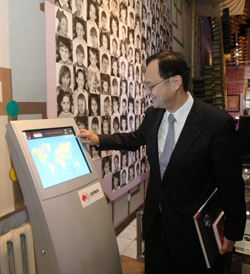Exhibits on a television screen
The “Chornobyl Museum” received new equipment for exhibitions from the government of Japan
For already about a month the National Museum “Chornobyl” has embraced a new form of excursion – using informational terminals, TV sets, projectors, players and other modern technologies. They managed to buy the new equipment owing to the support of the government of Japan, which allotted over 74,000 dollars to the museum within the framework of a small-scale grant assistance project in the sphere of culture. Yesterday the official ceremony of transferring the equipment took place. The project will enable museum employees to provide more information about the Chornobyl disaster, and visitors will be able to receive information without an accompanying guide, but rather through video films, audio records, etc.
“Japan has always supported Ukraine, especially in the sphere of overcoming the consequences of the Chornobyl disaster. The government of Japan cooperates with Ukraine on different levels, from big projects such as the Chornobyl foundation ‘Confinement,’ to projects of small-scale grant assistance in affected areas,” pointed out Ambassador Extraordinary and Plenipotentiary of Japan to Ukraine Tadashi Idzava. “Unfortunately, memory fades with time, therefore it is important to pass on information about past tragedies to future generations, also by means of modern technologies. Therefore we allotted funds to the museum, for the new equipment which will diversify its activity and increase the amount of information available for visitors. I will add that the museum ‘Chornobyl’ became the main site for tourists from Japan who want to obtain information about the tragedy at the Chornobyl atomic power plant.”
Employees of the museum completely agree with the words of Tadashi Idzava. They have already noticed the results of the new equipment: interest in the institution has increased considerably both among Kyiv residents and guests of the city.
“The terminal ‘Memory Book’ is especially popular. There everyone can find his or her relative or friend who participated in the liquidation of the accident at the Chornobyl atomic power plant,” continued the deputy director of the National Museum “Chornobyl” Anna Korolevska. “I repeatedly witnessed the joy of people when they find the names of their close ones in this book. Not less popular is the terminal with a quiz for visitors. After scrutinizing the exhibit one can test one’s knowledge about the catastrophe. This is generally a unique thing you won’t see in any other museum in Ukraine. I observed that sometimes people who didn’t answer some quiz question come back to a certain exhibit to find the answer. That is why we will surely translate this quiz into English and Russian. Currently it is only in Ukrainian. New archival filing cabinets were also presented for the museum. Previously documents were kept in wooden cabinets, now they will be kept in metal ones. They are a real salvation for us. Materials kept in the museum funds are documents from the 1970s-1980s, mainly very bad paper and ink of bad quality, and they are very difficult to preserve. With wooden cabinets we sometimes lose the text even though the texts are protected from sunlight.”
Both museum employees and research fellows of the Institute of History of the National Academy of Sciences of Ukraine worked on the question of what exactly would the new equipment show. Thus, historian Natalia Baranovska, who has been studying the Chornobyl tragedy for 20 years already, provided the museum with documents from her own archive. According to her, researchers started gathering their first pieces of document-evidence at the beginning of the 1990s, though this was quite difficult as most documents were classified. At present even visitors bring a lot of documents and household objects relevant to the catastrophe. In particular, this concerns residents of Kyiv, Prypiat and other settlements from within the 30-kilometer zone. Natalia is confident that the use of the modern technologies will make the museum a real research center.






